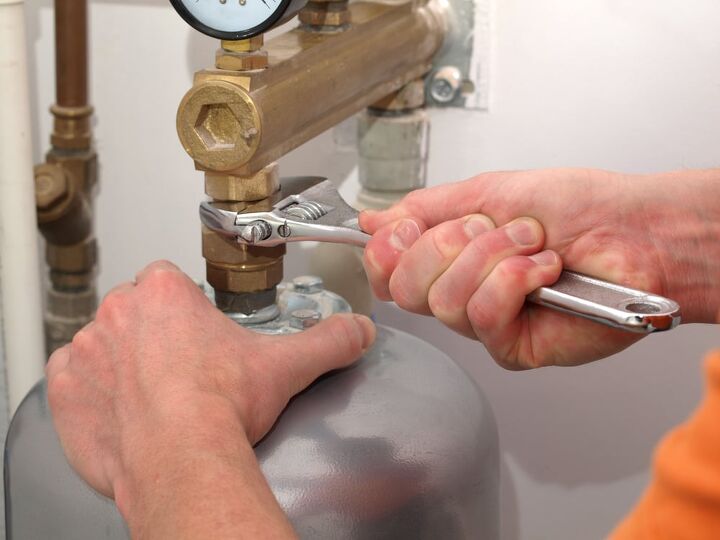Is Your Water Heater Expansion Tank Leaking? (We Have a Fix!)

Water heaters are a commodity in modern homes, and it can be stressful when something goes wrong. The expansion tank on a water heater is a critical component, and leaks are sometimes unavoidable. So, what does it mean when you find your water heater expansion tank leaking?
The most common reason for a water expansion tank leaking is that the pressure relief valve is damaged. Loose pipe fittings can also explain why your water expansion tank is leaking. Otherwise, you need to replace your water heater expansion tank if it is broken, and it costs an average of $361.
Loose pipe fittings are the easiest problem to solve if your water heater expansion tank is leaking. You can generally fix a leaking water expansion tank with plumber’s putty if the problem is minor. Follow along as explore the most common causes and solutions for a water heater expansion tank leaking.
Do You Need to Hire a Plumber?
Get free, zero-commitment quotes from pro contractors near you.

Water Heater Expansion Tank Leaking
It is important to tend to a leaking water heater expansion tank right away. The water can damage the area where your water heater is located and cause electrical damage. Luckily, there are several quick fixes for a water heater expansion tank leaking.
Damaged Pressure Relief Valve
The pressure relief valve on a water heater works to alleviate and regulate pressure. A damaged pressure relief valve can cause water to accumulate in your water heater expansion tank. Over time, too much water will build up in the expansion tank and cause it to leak.
A waterlogged expansion teak cannot work properly and you’ll need to empty the water heater and replace the pressure relief valve. Turn off the water heater from the breaker and the water supply so that it’s safe to work with. Place a bucket and towels beneath the drain valve and drain the remaining water from the tank.
Remove the damaged pressure relief valve with a wrench and screw the new one in place. Restore power to the heater and turn the water supply back on. If you find your water heating expansion tank leaking after this fix it indicates something else is wrong.
Loose Pipe Fittings
Loose pipe fittings can cause a water heater expansion tank to leak from the top or bottom in some cases. Inspect the pipes closely to identify which one is leaking and shut off the water supply and power. Dry the pipes with a towel or hairdryer if it is difficult to identify which fitting is leaking.
Open the pipe joints and clean the threads on the fittings with a plastic tool or fine brush. Apply waterproof plumber’s putty to the threads and reattach the old fitting. Replace the old fitting with a new one if it is too damaged or eroded.
Restore power to the water heater, turn the water supply back on, and see if the expansion tank still leaks.
Broken Expansion Tank
A leaking water heater expansion tank doesn’t always mean that it is broken, but there are other signs to look for. You can tell that your water heater expansion tank is broken if the water pressure fluctuates between high and low. It is also worth it to replace your water heater expansion tank if multiple components are shot such as the drain valve and pressure relief valve.
Water heater expansion tanks only last for 10 years on average, but they can go bad before then. Replace your water heater expansion tank if it is nearly 10 years old and multiple parts need to be replaced. Otherwise, replace the expansion tank if it is broken and has holes in it.
How to Replace a Water Heater Expansion Tank
Another possibility is that you’ve got a bad expansion tank or it’s simply worn out over time. Expansion tanks last about 5 years, up to 10 years if you maintain them well.
Therefore, it may be time for a new tank. You can typically buy a new expansion tank for about $40 to $50. Plus, with a little bit of DIY skill and effort, you can perform the installation yourself.
Tools You Need for the Job:
- Screwdriver
- Garden hose
- Bucket or towel
- Teflon tape
- Pipe wrenches or slip-joint pliers
Step 1: Disconnect the Power and Water to the Tank and Drain the Tank
Ensure that you turn off all the water supply valves to the expansion tank and main tank. Then cut the power to the tank, unplug it, and switch off the breaker. Additionally, turn off the gas feed if you have a gas-powered water heater.
Attach the garden hose to the expansion tank and drain the tank. Place the towel or bucket underneath the tank to catch any spills during the following steps.
Step 2: Remove the Support Strap
If your tank has a support strap keeping it in place, unscrew one side. If your tank doesn’t have a support strap, skip to the next step.
Step 3: Remove the Old Expansion Tank and Install the New
Use the slip-joint pliers to loosen the fittings securing the tank in place. Place the old tank to the side. Wrap the male threads with Teflon tape before you install the new tank.
Twist the new expansion tank into place and tighten it into place by hand. Then finish it off by tightening with the pliers.
Step 4: Check for Leaks
Once you’ve installed the new tank (the whole process should take about 30 minutes), test for leaks. Turn the water back on gradually and wait. You should hear the tank filling.
Examine the connections and the new tank, all should be well. If your tank has a support strap, make sure to resecure it. Finally turn back on any gas, power, pump, breakers, and valves that you shut off before making the replacement.
Do You Need to Hire a Plumber?
Get free, zero-commitment quotes from pro contractors near you.

Related Questions
What if your water heater is leaking?
Water heaters can leak for a number of reasons, including a faulty pressure valve, sediment buildup, and worn-out supply lines. In some cases, it could be the drain valve isn’t closing properly, allowing water to leak onto the floor.
You can try to troubleshoot your water heater yourself, as some repairs can be minor. However, if you suspect more significant issues, it’s best to call a plumber.
Do water heater expansion tanks go bad?
Water heater expansion tanks go bad after 12 years on average. They can go bad after 10 years or sooner if the tank undergoes damage or your install it incorrectly. You can tell that it’s time to replace your water heater expansion tank if water leaks from air valve.
Summing It Up
Loose pipe fittings and a damaged pressure relief valve are the most common reasons for a water heater expansion tank leaking. Remove the old pipe fitting, clean the threads, and apply plumber’s putty to fix a leak. Replace the pressure relief valve if it is damaged because it can waterlog your expansion tank and make it leak.
Otherwise, you will need to replace the expansion tank if it is 10-12 years old or broken. It is nearly impossible to repair a water heater expansion tank that has holes in it.
Related Guides

Stacy Randall is a wife, mother, and freelance writer from NOLA that has always had a love for DIY projects, home organization, and making spaces beautiful. Together with her husband, she has been spending the last several years lovingly renovating her grandparent's former home, making it their own and learning a lot about life along the way.
More by Stacy Randall












![10 Best Zero Turn Mowers – [2022 Reviews & Ultimate Buyer's Guide]](https://cdn-fastly.upgradedhome.com/media/2023/07/31/9070522/10-best-zero-turn-mowers-2022-reviews-ultimate-buyer-s-guide.jpg?size=350x220)














